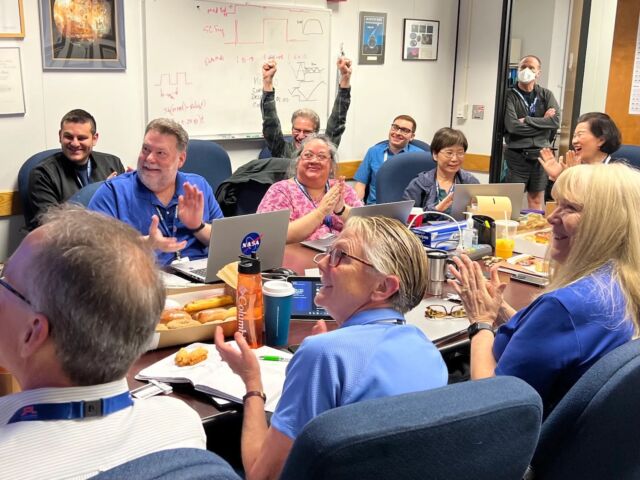Engineers have partially restored a 1970s-era computer on NASA’s Voyager 1 spacecraft after five months of long-distance troubleshooting, building confidence that humanity’s first interstellar probe can eventually resume normal operations.
Several dozen scientists and engineers gathered Saturday in a conference room at NASA’s Jet Propulsion Laboratory, or connected virtually, to wait for a new signal from Voyager 1. The ground team sent a command up to Voyager 1 on Thursday to recode part of the memory of the spacecraft’s Flight Data Subsystem (FDS), one of the probe’s three computers.
“In the minutes leading up to when we were going to see a signal, you could have heard a pin drop in the room,” said Linda Spilker, project scientist for NASA’s two Voyager spacecraft at JPL. “It was quiet. People were looking very serious. They were looking at their computer screens. Each of the subsystem (engineers) had pages up that they were looking at, to watch as they would be populated.”
Finally, a breakthrough
Launched nearly 47 years ago, Voyager 1 is flying on an outbound trajectory more than 15 billion miles (24 billion kilometers) from Earth, and it takes 22-and-a-half hours for a radio signal to cover that distance at the speed of light. This means it takes nearly two days for engineers to uplink a command to Voyager 1 and get a response.
In November, Voyager 1 suddenly stopped transmitting its usual stream of data containing information about the spacecraft’s health and measurements from its scientific instruments. Instead, the spacecraft’s data stream was entirely unintelligible. Because the telemetry was unreadable, experts on the ground could not easily tell what went wrong. They hypothesized the source of the problem might be in the memory bank of the FDS.
There was a breakthrough last month when engineers sent up a novel command to “poke” Voyager 1’s FDS to send back a readout of its memory. This readout allowed engineers to pinpoint the location of the problem in the FDS memory. The FDS is responsible for packaging engineering and scientific data for transmission to Earth.
After a few weeks, NASA was ready to uplink a solution to get the FDS to resume packing engineering data. This data stream includes information on the status of the spacecraft—things like power levels and temperature measurements. This command went up to Voyager 1 through one of NASA’s large Deep Space Network antennas Thursday.
Then, the wait for a response. Spilker, who started working on Voyager right out of college in 1977, was in the room when Voyager 1’s signal reached Earth Saturday.
“When the time came to get the signal, we could clearly see all of a sudden, boom, we had data, and there were tears and smiles and high fives,” she told Ars. “Everyone was very happy and very excited to see that, hey, we’re back in communication again with Voyager 1. We’re going to see the status of the spacecraft, the health of the spacecraft, for the first time in five months.”

Throughout the five months of troubleshooting, Voyager’s ground team continued to receive signals indicating the spacecraft was still alive. But until Saturday, they lacked insight into specific details about the status of Voyager 1.
“It’s pretty much just the way we left it,” Spilker said. “We’re still in the initial phases of analyzing all of the channels and looking at their trends. Some of the temperatures went down a little bit with this period of time that’s gone on, but we’re pretty much seeing everything we had hoped for. And that’s always good news.”
Relocating code
Through their investigation, Voyager’s ground team discovered a single chip responsible for storing a portion of the FDS memory stopped working, probably due to either a cosmic ray hit or a failure of aging hardware. This affected some of the computer’s software code.
“That took out a section of memory,” Spilker said. “What they have to do is relocate that code into a different portion of the memory, and then make sure that anything that uses those codes, those subroutines, know to go to the new location of memory, for access and to run it.”
Only about 3 percent of the FDS memory was corrupted by the bad chip, so engineers needed to transplant that code into another part of the memory bank. But no single location is large enough to hold the section of code in its entirety, NASA said.
So the Voyager team divided the code into sections for storage in different places in the FDS. This wasn’t just a copy-and-paste job. Engineers needed to modify some of the code to make sure it will all work together. “Any references to the location of that code in other parts of the FDS memory needed to be updated as well,” NASA said in a statement.

